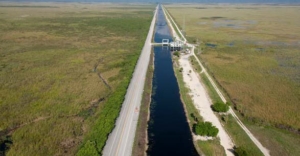We Can’t Stop Now by Eric Eikenberg CEO Everglades Foundation
 We’ve made more progress on Everglades restoration in the past two years than in the previous two decades — but we can’t stop now.
We’ve made more progress on Everglades restoration in the past two years than in the previous two decades — but we can’t stop now.
America’s Everglades is a national treasure. A place unlike any on Earth, it is the largest subtropical wilderness in the nation and is home to scores of rare and endangered species such as the Florida manatee, the American crocodile and the Florida panther. It is a birder’s paradise and one of the finest sport fishing areas in the world.
Yet this magnificent ecosystem is on life support, parched during the dry season and poisoned by excess nutrients during the rainy months. More than half of the freshwater that once flowed through the Everglades into Florida Bay has been siphoned off, while billions of gallons of freshwater are instead being flushed out to sea for flood control, feeding toxic blue-green algae and red tide.
Twenty years ago, scientists and policymakers agreed on a solution: the Comprehensive Everglades Restoration Plan, CERP, is a suite of 68 separate projects, all designed to mimic South Florida’s historic southerly flows. Instead of discharging precious fresh water out to sea, CERP envisions storage reservoirs and man-made wetlands to purify it so it can be sent south to nurture the Everglades and restore a healthier saltwater balance in Florida Bay.
Still, not one of the CERP projects has been brought to completion, but it now appears that Everglades restoration is getting a kick start. The State of Florida is in the midst
of an unprecedented four-year, $2.5 billion commitment to environmental and water issues, including more than $640 million for Everglades restoration in each of the past two
years. In Washington, Congress has upped the federal contribution for Everglades restoration to more than $200 million in each of the last two years.

Newly constructed bridges under Rte 41, the Tamiami Trail, have restored the southward flow of water into the Northern Everglades for the first time in a century.
These investments are already having a profound effect. Route 41, the Tamiami Trail, has been raised to allow water to flow freely into the northern Everglades. Already, habitat is being restored and wildlife is returning to what was scorched Earth. Storage reservoirs are nearing completion to the east and west of Lake Okeechobee and, to the south, ground has been broken on the so-called “Everglades Reservoir,” a pivotal piece of the puzzle that, together with the other projects now underway, will cut algae causing discharges by more than half.
Together, these projects will create upwards of 45,000 high paying construction jobs for families emerging from the pandemic. What’s more, studies show that every $1 invested in Everglades restoration generates $4 in benefits to Florida’s economy. What’s needed now is for Washington to catch up with its funding obligations with a 10-year, $7 billion commitment to complete the projects that have already been approved by Congress and are included in the U.S. Army Corps of Engineers’ Integrated Delivery Schedule.
After 20 years of delay, we can’t wait any longer. We are finally making progress, and it is no time to stop.




Leave a Reply
Want to join the discussion?Feel free to contribute!